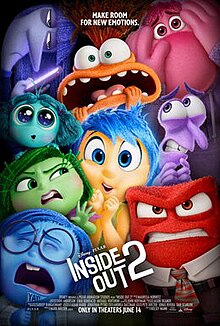
Disney and Pixar released “Inside Out” to theaters on June 19 in 2015. A heartfelt movie about a young girl named Riley and the emotions in her head, embodied by adorable, colorful characters.
This movie quickly became one of my favorites, even once I became too old for Disney movies. It has many underlying messages about how negative emotions can be needed, how your priorities change when you get older, and how change can be difficult, but not necessarily bad.
When Disney announced that there would be a sequel, I had mixed feelings. On one hand I was thrilled — an additional plot to my favorite movie? I couldn’t wait to add another classic to my rotation of Disney movies. But on the other hand, I was nervous — what if it didn’t do justice to the first one? What if I couldn’t stomach watching the first movie if the second one ruined it for me?
The night my friends and I went to the theater to watch “Inside Out 2,” we knew, from watching endless TikToks about how emotionally taxing this movie was, that it could be a rough evening. We had gotten so many mixed reviews, we didn’t know whether to be afraid or excited.
A few points in the movie made me cringe so bad I almost couldn’t finish watching. (Spoiler Warning). The first was when Riley’s friends told her they weren’t going to the same high school as her. Her brain immediately resorted to the worst case scenario and it made me think about every time I’ve been given disappointing news, because just like Riley, the most irrational thoughts plagued me to the point of a meltdown.
The next scene giving me secondhand embarrassment was when Joy (Riley’s happiness emotion) made Riley goof around with her friends in the locker room, embarrassing them in front of their new coach and mature varsity players. I was mad at Joy in this scene because it felt like she didn’t understand how important maturity was in this moment and I definitely relate to that. It was junior year before I became socially aware and able to read a room, so I’ve spent a lot of time embarrassing myself and trying to prove I’m mature and responsible. As we grow up, the transition to maturity resembles this moment fairly well.
The biggest scene that was hard to watch, and I feel like a lot of teens will agree with me, was the “Anxiety Attack” scene. The embarrassment Riley felt after her selfishness caused her friend to get hurt, was incredibly overwhelming. This led Anxiety to take over, an infestation in her mind with racing and irrational thoughts, to the point where she couldn’t calm down. My friends were in tears at this point, and I was close, all of us able to recall a time when we’ve felt the same way.
These are things most people, especially teens, can relate to and I think that’s why it was such a hard movie to watch. I really liked this movie — I’ll just have to be in a good headspace to watch it again. And it definitely didn’t hinder the first movie, that one is still a staple.

